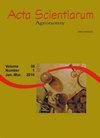高β-胡萝卜素甘薯农艺性状的基因型与环境互作
IF 1.2
4区 农林科学
Q3 AGRONOMY
引用次数: 0
摘要
甘薯(Ipomoea batatas L.)因其营养价值和生产力而成为世界范围内对人类健康重要的块茎蔬菜。食用橙肉甘薯有助于对抗世界上包括巴西在内的维生素A缺乏症,因为这些块茎富含维生素A的前体β-胡萝卜素。基因型与环境的相互作用是植物育种中最大的挑战之一,特别是在品种的选择和批准方面。在这种情况下,适应性和稳定性分析是有必要的,以评估各种基因型对某些环境的一般或特定适应的表现,并确定对环境变化有反应的基因型。因此,本研究的目的是评估基因型与环境的相互作用,并评估甘薯基因型的适应性和稳定性,以确定和选择有希望的育种候选品种。试验在四个环境中进行:本文章由计算机程序翻译,如有差异,请以英文原文为准。
Genotype × environment interaction for the agronomic performance of high β-carotene sweetpotato
Sweetpotato (Ipomoea batatas L.) is an important tuber vegetable for human health worldwide owing to its nutritional value and productivity. Consumption of orange-fleshed sweetpotato is beneficial to combat vitamin A deficiency in the world, including Brazil, as these tubers are rich in β-carotene, a precursor of vitamin A. The genotype × environment interaction is one of the greatest challenges in plant breeding, specifically in the selection and approval of cultivars. In this context, adaptability and stability analyses are warranted to evaluate the performance of various genotypes in terms of general or specific adaptations to certain environments and to identify genotypes responsive to environmental variations. Thus, the objective of this study was to evaluate the genotype × environment interaction as well as to estimate the adaptability and stability of sweetpotato genotypes for identifying and selecting promising candidates for breeding. The experiments were performed in four environments: Vera Cruz in São Paulo, Selvíria in Mato Grosso do Sul, and one organic and another intercropped production system in Sete Barras in São Paulo. A randomized block design with two replicates was adopted. A total of 265 genotypes were tested, and the orange-fleshed sweetpotato cultivar ‘Beauregard’ was used as the control. The additive main effects and multiplicative interaction model was used to study environmental stratification, adaptability, and stability. The genotype × environment interaction was evident in all environments. The genotypes CERAT21-13 (marketable root yield, 22.30 t ha-1 in the four environments), CERAT29-26 (27.74 t ha-1), and CERAT52-22 (20.24 t ha-1) were the most adapted in general to the four environments. CERAT25-23, CERAT29-23, and CERAT29-26 were the most adapted to the environment in Vera Cruz; CERAT29-26, CERAT34-14, and CERAT56-32 to the environment in Selvíria; and CERAT31-10, CERAT35-19, and CERAT52-22 to the two environments in Sete Barras.
求助全文
通过发布文献求助,成功后即可免费获取论文全文。
去求助
来源期刊

Acta Scientiarum. Agronomy.
Agricultural and Biological Sciences-Agronomy and Crop Science
CiteScore
2.40
自引率
0.00%
发文量
45
审稿时长
>12 weeks
期刊介绍:
The journal publishes original articles in all areas of Agronomy, including soil sciences, agricultural entomology, soil fertility and manuring, soil physics, physiology of cultivated plants, phytopathology, phyto-health, phytotechny, genesis, morphology and soil classification, management and conservation of soil, integrated management of plant pests, vegetal improvement, agricultural microbiology, agricultural parasitology, production and processing of seeds.
 求助内容:
求助内容: 应助结果提醒方式:
应助结果提醒方式:


